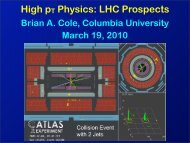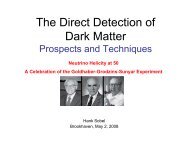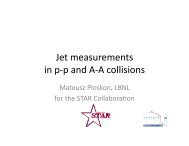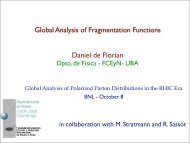One flavor QCD Abstract - BNL theory groups - Brookhaven National ...
One flavor QCD Abstract - BNL theory groups - Brookhaven National ...
One flavor QCD Abstract - BNL theory groups - Brookhaven National ...
Create successful ePaper yourself
Turn your PDF publications into a flip-book with our unique Google optimized e-Paper software.
Assuming only the matching conditions in Eq. (54,55) leaves the freedom to do some amusing<br />
things. As a particularly contrived example, consider<br />
˜g = g (56)<br />
˜m = m − Mg γ 0/β 0<br />
× e−1/2β 0g 2 g −β 1/β 2 0<br />
Λ qcd a<br />
. (57)<br />
The last factor vanishes than any power of g, but is crafted to go to unity along the renormalization<br />
group trajectory. Note that a power of the scale factor as inserted here is necessary for<br />
non-perturbative phenomena to be relevant to the continuum limit [31]. With this form, one can<br />
immediately relate the old and new renormalized masses<br />
˜M ≡ lim<br />
a→0<br />
˜m ˜g −γ 0/β 0<br />
= M − M = 0. (58)<br />
Thus for any M, another scheme always exists where the renormalized quark mass vanishes. The<br />
possibility of such a transformation demonstrates that masslessness is not a physical concept for<br />
the one <strong>flavor</strong> <strong>theory</strong>, or more generally for a non-degenerate quark in a multi-<strong>flavor</strong> <strong>theory</strong>.<br />
I close this section with some remarks on trying to define the quark mass is through the operator<br />
product expansion. Expanding the product of two electromagnetic currents at small separations<br />
will bring in a variety of quark operators. Among them is the simple scalar combination ψψ. The<br />
short distance behavior involves a triangle diagram which by γ 5 symmetry should vanish when the<br />
quark mass does. Thus one might define the zero mass <strong>theory</strong> where the coefficient of the singular<br />
part of this term in the operator product expansion has a zero.<br />
This approach raises several issues. Because the ’t Hooft vertex in the one <strong>flavor</strong> <strong>theory</strong> takes<br />
the same form ψψ, it clouds the definition of this as a renormalized operator. The same scheme<br />
dependent additive shift that plagues the quark mass can modify where this zero occurs. Furthermore,<br />
the additive shift in the quark mass makes it unclear whether this definition of vanishing<br />
quark mass has any connection with the quark masses in some particular effective chiral<br />
Lagrangian. It is even possible that the zero mass <strong>theory</strong> defined this way may be in the CP violating<br />
phase, in which case it certainly doesn’t represent something physically interesting. Indeed,<br />
it is unclear what experiment if any could determine if the quark mass defined via the operator<br />
product expansion vanishes.<br />
22






